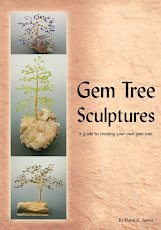Competition
Well we made it back from the Regional competition in Ontario, Oregon. Boy was it hot. Going from 60 degrees to 90 degrees was a bit much and drained us completely of energy by early afternoon. I set up my display case on Thursday and the judging was on Friday. I had the unfortunate luck of not having any lights in my display during judging. Thankfully, they did not count that against me....not something I had control over. I was dinged on a couple of other items but that is fixable. The trees however were a big success and everyone including the judges thought they were great. Here is a picture of my display case showing the trees and the blue ribbon earned. The pine tree in the back row seemed to be the favorite from most everyone I talked to with the bonsai tree front right was next.
The pine tree in the back row seemed to be the favorite from most everyone I talked to with the bonsai tree front right was next.
I was able to promote my upcoming book as several people came up to me and wanted to know how to make them.
I have a couple of additional questions out to one of my judges for clarification of labeling for my competition next year. Next year it has to be perfect to take the Sweepstakes award at the National level.
Of these trees, I will be holding onto the Smoky Quartz (top left), Malachite Pine tree (top middle) and the bonsai which is a Pearl tree on Carnelian (bottom right). One of the new trees I will add to this collection for next years competition is a palm tree made with Labradorite stones. The palm tree is a completly different style as the limbs wire is braided vs. twisted and the trunk wire is woven on a support core of copper tubing. I have a year to make it so I'll have to get started on a prototype. I'll post a picture out here when it is finished.
If you have any comments, I would love to hear from you. As I have mentioned before, some of my previous posts for 2007 in this blog do have instructions for building a gem tree.

















